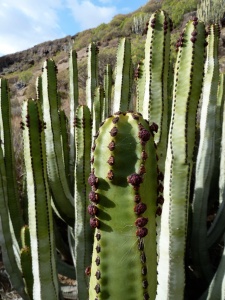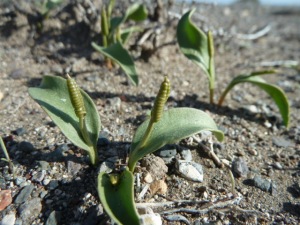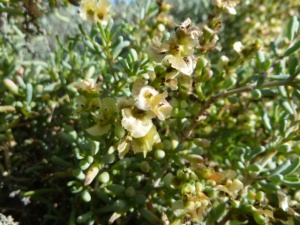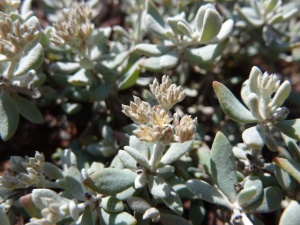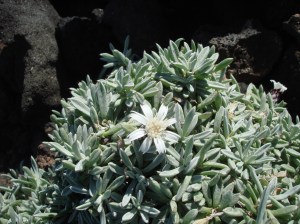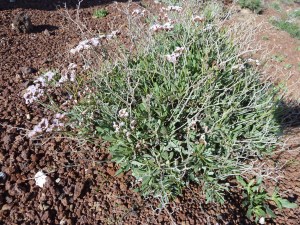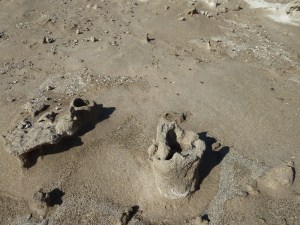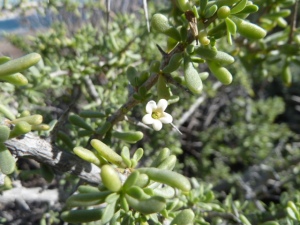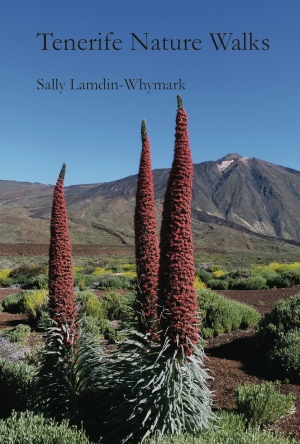Blog Archives
A walk from Tajao on the south coast of Tenerife
Posted by Sally Whymark

Rocks in the barranco near the beginning of the walk showing the varied geology. The grass plant in front of the boulder is the very invasive introduced plant, Pennisetum setaceum.
I did this walk with a group of friends two weeks ago on the 2nd April. We decided to do a walk near the coast as the weather was a bit uncertain, and there were black clouds up the hills. So we thought we would explore the area inland from Tajao, as we had not walked there before. By walking near the coast we managed to avoid rain except for a few tiny drops at our highest point, and we saw an abundance of flowers, some endemic, others native and many ruderals and introduced species mainly from Europe.
I haven’t posted about this walk before as we saw so many flowers that I still have not identified all of them in the few spare minutes that I have had. However, I thought I had got names for enough of them to make a post now, to share with interested friends.

Canary Volutaria (Volutaria canariensis) A widespread annual growing to about 2 ft / 60cm high. It is a Canary endemic
I am not going to describe the walk as it was not the most inspiring walk I’ve done, and am not likely to do it again myself, since it passed through a quarry, where the track we were on disappeared, then having gained another track on a ridge we looked across at what turned out to be a landfill site! Further on we passed a solar farm, and an intensive animal farm with modern sheds and silos, though we could not see what animals it housed. So it was not the most scenic walk I have done in Tenerife, but it did have its moments, and it also passed through several areas of natural basal zone vegetation which were interesting.

Canary rock rose (Helianthemum canariense) is a canary endemic which likes open rocky sites in the basal zone.
We were following a track we had downloaded from Wikiloc contributed by the user “Rutas de Tenerife” which you will find at the following link: http://www.wikiloc.com/wikiloc/view.do?id=4025346
However, be warned. We lost our way in the quarry where recent work appeared to have destroyed the path we were following, and we also lost our way halfway down the descent, in an area of loose rocks which was difficult to walk on without a path.
The plants that are illustrated are relatively common near the coast in the south of the island, so I hope it will interest you on walks in the south even though this walk was not the most recommended!

Volutaria tubuliflora is an annual which is a more widespread (non endemic) species of Volutaria. They are related to the knapweeds.

A typical view of the vegetation in the rocky part of the descent, with a Mataperros, (Ceropegia fusca) in the foreground (grey stick-like), Balo (Plocama pendula) the drooping shrub behind, Bitter spurge (Euphorbia lamarckii) the yellowing bush to its right, and Cardón (Euphorbia canariensis) the candlesticks behind.
Posted in Botanical interest, South Tenerife, Walks in Tenerife
Tags: Ajuga iva, Bartsia latifolia, Canary rock-rose, Canary spurge, Cardon, Ceropegia fusca, Euphorbia canariensis, Fagonia albiflora, Frankenia capitata, Helianthemum canariense, hiking, Lotus sessilifolius, nature, Pennisetum setaceum, Polycarpaea nivea, Reseda scoparia, senderismo, Senecio glaucus ssp coronopifolius, Tajao, Tenerife, Volutaria canariensis, Volutaria tubuliflora, walking
A botanical excursion to the Montaña Roja nature reserve, El Medano
Posted by Sally Whymark
Two friends who are keen botanists, like myself, did this short excursion on 17th December, but I did not have time to post a blog on it before I went away for Christmas. When we visited it was 7 days after the storm which dropped a great deal of rain in Tenerife, and especially in the south. We went to see a tiny fern which only appears after rain, and is just 3-5 cm high, which one of my friends had seen there, the Adders Tongue, Ophioglossum polyphyllum.
We parked on the car park about 600m from the car park on the edge of El Medano, where the windsurfers go, along the road to Los Abrigos, and right by a junction where a road opposite the car park goes to the Cueva de Hermano Pedro. From there we walked straight into the reserve and found the Adders Tongue fern just about 50-100 m from the road, in an open gravelly area. It is a delightful little plant, worth looking for and admiring, though most people would simply not notice it.
After enjoying the tiny ferns, we walked further towards the sea and found some circles of wire netting surrounding some very rare plants, Piñamar (literally Sea pineapple) Atractylis preauxiana. It is a canarian endemic and on Tenerife is only barely surviving in very few sites. The authorities have obviously tried to establish a new site in El Medano. Some of the plants looked as if they were getting on OK, though others looked dead. It might be worth returning in about a month to see if they are flowering.
There were lots of other common coastal plants starting to flower, including the Common white saladillo (Polycarpaea nivea), the Canary bird’s foot trefoil, (Lotus sessilifolius), the Chicken wire plant, Aulaga, (Launaea arborescens), Matabrusca negra (Salsola divaricata), Branching heliotrope (Heliotropium ramosissimum), Sea everlasting (Limonium pectinatum) and Canary Island rockrose (Helianthemum canariense).
We wandered towards the sea to take a look at the de-watering structures, or sismata in Spanish. They are curious geological structures to be found over a fairly wide area of the fossilised dune system, and are the result of an earthquake shaking a water-saturated sediment, causing water to need to escape from the sediment. The water flowed out via tubular structures which became more mineralised than the surrounding sediment and subsequently when the area is eroded, the sismata are more resistant to erosion and so stick up above the surrounding surface.
After that we wandered up the lower slopes of Montaña Roja, where more shrubby plants were growing, dominated by the common coastal spurge, the Sweet spurge or Tabaiba dulce in spanish (Euphorbia balsamifera). There were also examples of the Canary spurge, Cardón, (Euphorbia canariensis), and the little grey candelabra cactus, Cardoncillo gris (Ceropegia fusca), which was flowering, with its curious-shaped red flowers. Espino del Mar (literally Sea thorn) (Lycium intricatum) was also plentiful. Among the Sea thorn plants with the usual tiny trumpet-shaped purple flowers, I saw one with creamy-white flowers.
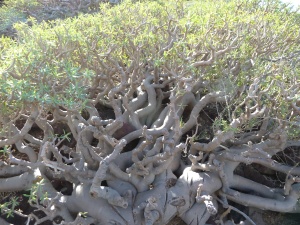
A very old, semi-prostrate shrub of Sweet spurge, or Tabaiba dulce (Euphorbia balsamifera) on the lower slopes of Mt Roja. Notice the slash marks on the lower branches.
It was noticeable that all the lovely old shrubs of Sweet spurge, which were mostly layered into the mountainside, had slash marks in their basal branches. I wondered whether this had been done to extract the latex which was used traditionally for medicine.
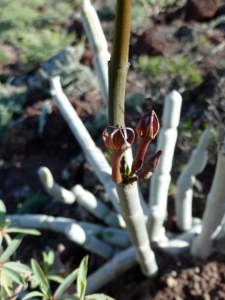
Cardoncillo gris – literally the little grey candelabra cactus (Ceropegia fusca) with its curious red flowers
As we walked around the lower slopes of the mountain, I noticed a number of plants which I guessed was a wormwood (Artemesia family) but a species I had not previously seen. Fortunately some were in flower, and when I got home I could confirm from my books that it was Artemesia reptans. My favourite book for the endemic plants, David Bramwell’s ‘Wild Flowers of the Canary Islands’ says it is only found in Gran Canaria, but when I checked with the Flora de Canarias website I discovered it is found in Tenerife as well, and the picture on the site was taken near Montaña Roja where we had seen it ourselves. So that discovery made it a very exciting and satisfying little ramble from the botanical point of view.

Incienso menudo or amuley (Artemesia reptans) does not have an English name. It is a miniature wormwood.
I am not giving exact time or distance for this walk as it was a gentle wander around a nature reserve, looking at plants of interest. We spent around 2 hours there, which we enjoyed tremendously.
Posted in Botanical interest, South Tenerife, Walks in Tenerife
Tags: Adders tongue fern, Amuley, Artemesia reptans, Atractylis preauxiana, Canary birds foot trefoil, Cardoncillo gris, Ceropegia fusca, de-watering structures, El Medano, Espino de mar, Euphorbia balsamifera, Granadilla, hiking, Incienso menudo, Limonium pectinatum, Lotus sessilifolius, Lycium intricatum, Matabrusca negro, Ophioglossum polyphyllum, Piñamar, Polycarpaea nivea, saladillo blanco común, Salsola divaricata, Sea everlasting, senderismo, sismatas, South Tenerife, Sweet spurge, Tabaiba dulce, Tenerife, walking






